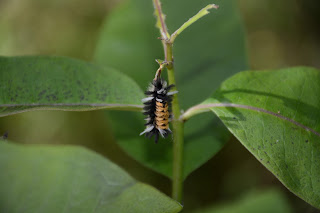This was it for trash and so little made this a great day. I hiked an access road today with Penny. It is open to traffic, so there can be a lot of garbage on its sides. This would be a pretty boring post if that was it. The lack of trash gave me time to look for wildlife and this is a good time of year to see certain insects and arachnids. Here is what I found today.
The first insect find of the hike. A Wooly Bear Caterpillar. (Pyrrharctia isabella) I know I have seen thousands of these. I don't think I have ever seen the moth that these become. Have you? Ever wonder? I never did until today. Look up the scientific name and see what they become.
These are Milkweed Bugs on a Milkweed seed pod. The larger one at the lower end of the seed pod with black patches is an adult, the rest are immatures. Did you know that a bug is an insect, but not every insect is a bug? So what's the difference? Bugs are insects of the Order Hemiptera. All have piercing/sucking mouthparts, like a straw for a mouth. Some use this specialized mouth for feeding exclusively on plants, tapping into either the xylem or phloem. Others use it for sucking out the insides of living things, mostly smaller insects. I have seen Giant Water Bugs feeding on small Pickerel Frogs. Bugs also have Hemelytra. This is a forewing that is half solid, half membranous, but there are some bugs that do not have this. Cicadas have membranous forewings and are one of the exceptions. Probably more than you wanted to know about bugs.
This is a Marbled Orb Weaver. I think I posted a photo of one of these earlier this week. This shot I know is a different angle and shows the awesome patterning and coloration. There were many of these out and about today.
Lots of Sawfly larvae today. These are in the Order Hymenoptera and are closely related to bees and wasps.
Is that a half dead leaf? Nope! It is a moth caterpillar. More specifically, a Lacecapped Caterpillar which will eventually become a Streaked Prominent Moth. (Oligocentria lignicolor)
There are a couple species that look similar to this caterpillar. I think this is a White-Headed Prominent Moth Caterpillar. There were many of these today.
A better look at a Lacecapped Caterpillar.
Not sure what this caterpillar is. I do see these often. If I find out what this is I will update the post later. UPDATE: This has been identified as a Hickory Tussock Moth Caterpillar.
The largest insect find of the day. This is a Polyphemus Moth Caterpillar. (Antheraea polyphemus) If you take a good look at the photo on the right, I think you too would agree that it has a face only an entomologist would love.
Another Orb Weaver that had fashioned itself a home out of a leaf.
This is a Sulfur Butterfly. I think the species is Colias eurytheme, but I am not positive. Sulfurs are very common, but are not the easiest to photograph.
A Spread Winged Damselfly. I do not know the species. Generally you can tell a Damselfly from a Dragonfly by the way they hold their wings at rest. In most cases Damselflies will hold their wings strait up and Dragonflies hold theirs out to their sides. This type of Damselfly is an exception to the rule and at rest hold their wings out like Dragonflies.
Like the Milkweed Bugs this is another insect that is commonly found on Milkweed at this time of year. This is a Milkweed Tussock Moth Caterpillar. (Euchaetes egle) Milkweed really does provide for many hosts. This caterpillar and Monarch caterpillars feed on the leafs and Milkweed Bugs and Aphids tap into the plants veins to feed.
Another fuzzy caterpillar that I have not the slightest idea of what it is. For this one too I will try to figure it out and update the post later.
A Yellownecked Caterpillar. (Datana ministra) Generally there is a different common name for the moth that the caterpillars become, in this case it is just the Yellownecked Caterpillar Moth.
This caterpillar is called a Wavy-Lined Heterocampa. (Heterocampa biundata) This was the last new find of the day.
I know I did not take out much trash today, but I hope that this post was still interesting. As the days start getting colder I will not be going out on the river as much and I think I will have more posts like this. Some days walking trails and access roads I do come across large trash piles, but there will be many days like today where there will be more wildlife than trash. Those are really the best days and I wish everyday could be like that.
If you like what I am doing and enjoy the posts you can make a contribution at gofundme.com/takingoutthetrash to help me continue this project through 2016.


















Black and white caterpillar is Hickory Tussock Moth (Lophocampa caryae) and the damsel is a Great Spreadwing.
ReplyDeleteThank You Stephen!
ReplyDelete